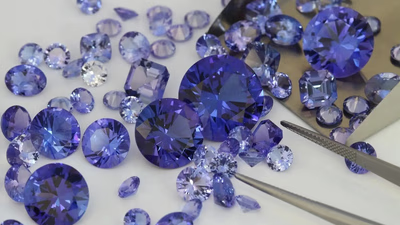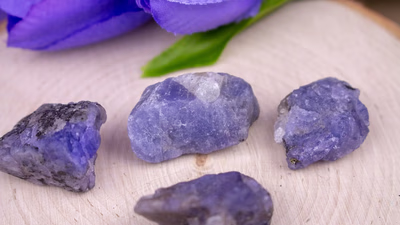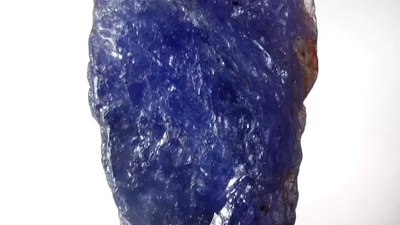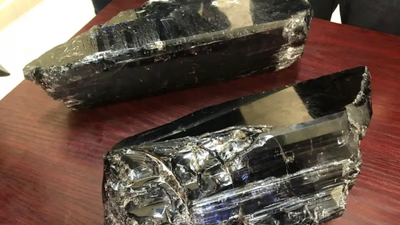
Tanzanite gemstone showcasing its unique blue-violet hues.
Tanzanite is a blue to violet gemstone that is a variety of the mineral zoisite. It was discovered in the Mererani Hills near Arusha in northern Tanzania, which is the only known source of the stone, hence its name. Tanzanite exhibits a striking blue to violet color, which can appear differently depending on the orientation of the crystal and the lighting conditions. This phenomenon is known as pleochroism. The gemstone was discovered in 1967 by a Masai tribesman and was later popularized by Tiffany & Co., which named it "tanzanite" after its country of origin.
Tanzanite stone is one of the minerals that was first discovered in Tanzania and is still the only source of this stone in Tanzania. Tanzanite is a group of zosite minerals with a chemical formula of calcium aluminum silicate, which has a hardness of 6.5 to 7. Tanzanite is one of the best-selling gemstones in the market. Given that it was only known in the 1960s, this is surprising since all the other best-selling colored stones have been known for centuries. It is its unique blue color that has become popular with most of the people and it will become more popular in the future.
Tanzanite (TANZANITE) is a beautiful blue variety (blue-violet from light to dark and purple-blue and pure blue) of the mineral zoisite. This beautiful stone is found only in a small area with a width of 4 km and a length of 2 km on the slopes of Kilimanjaro in Tanzania. That is why it is called tanzanite. However, in the early 1980s and early 1990s tanzanite became widely available in gem quality. Until 1960, they could not find a large amount of this precious gem.
According to some people, this gem was first discovered by the Maasai tribesman, Ali Joyawato. Others consider its discoverer to be Ndago Homan Ngoma. Another report states that the tanzanite gem was first found on July 8, 1967 by Manuel de Souza. In 1967, when the first tanzanite was cut and ready for the market, jewelers and the general public knew nothing about this gem. They had never seen its blue color and never heard of it. To introduce the world to tanzanite, Tiffany & Co. launched a public education program.
Tanzanite has a blue to purple color spectrum, and it is somewhat similar to alexandrite stone, and similar to alexandrite, it shows different colors, which is due to the presence of vanadium in this stone. Azure and dark blue tanzanite is one of the most popular types of these stones. which looks more purple under artificial light. The dark blue color of tanzanite stone is similar to sapphire, which becomes a little darker after heating. Tanzanite's unique beauty and limited geographic source contribute to its desirability and value as a gemstone.
Tanzanite is formed under very specific geological conditions and is found in a relatively small area, making it a rare gemstone. Most tanzanite on the market has been heat-treated to enhance its blue and violet hues. The natural color of tanzanite can range from brownish to greenish before treatment. On the Mohs scale of hardness, tanzanite ranks about 6 to 7, making it somewhat susceptible to scratching and chipping. It requires careful handling and setting in jewelry to avoid damage. The value of tanzanite depends on its color, clarity, cut, and carat weight. Deep, vivid blue or violet stones without visible inclusions are the most prized.
-

Tanzanite stones are valued for their vibrant blue and violet hues, with high-quality specimens exhibiting strong pleochroism and minimal inclusions. The clarity, cut, carat weight, and certification from reputable gemological laboratories are crucial factors in determining the stone"s value. Authentic tanzanite is exclusively sourced from Tanzania, making verification of origin essential. Larger stones with deep colors are generally more valuable, but quality should not be compromised for size. The gemstone"s hardness ranges from 6 to 7 on the Mohs scale, indicating it may be prone to scratches and damage, which makes it less suitable for everyday wear. Buyers should inspect tanzanite using a jeweler’s loupe to check for clarity and any visible flaws. Comparing multiple stones can help assess color saturation and quality. Genuine tanzanite displays different colors under varying lighting conditions and may exhibit a soft glow under UV light.
Most tanzanite is heat-treated to enhance color; untreated stones are rare and can have different values. A gemological report is essential for confirming authenticity and detailing any treatments the stone has undergone.
-

Tanzanite is a unique blue to violet gemstone, a variety of zoisite, discovered in Tanzania"s Mererani Hills. Its striking color can change based on crystal orientation and lighting, a phenomenon known as pleochroism. First found in 1967 by a Maasai tribesman, tanzanite gained popularity through Tiffany & Co. , which named it after its origin. The gemstone"s rarity stems from its exclusive source, making it highly desirable. With a hardness of 6. 5 to 7 on the Mohs scale, tanzanite is somewhat vulnerable to scratches and requires careful handling. Most stones available today are heat-treated to enhance their color, which ranges from brownish to greenish before treatment.
The value of tanzanite is determined by its color, clarity, cut, and carat weight; deep blue or violet stones without inclusions are the most sought after. Despite being relatively new to the market compared to other gemstones, tanzanite"s unique beauty and limited availability contribute to its growing popularity. "
-

Tanzanite is a unique gemstone known for its captivating blue and violet hues, which can vary based on viewing angles due to its pleochroic nature. The most sought-after color is deep blue, with larger stones exhibiting more intense shades. Violet tanzanite, while also valued, is less popular than the blue variety. Green tanzanite, or "chrome tanzanite," is rarer and less valued compared to its blue and violet counterparts. Untreated tanzanite can show brown or yellow hues but is often heat-treated to enhance its appeal. The gemstone"s origins trace back to Tanzania, where it was first discovered and named by Tiffany & Co. in the 1970s. The market primarily consists of heat-treated stones due to their vibrant colors, while untreated stones are prized by collectors for their rarity.
Cat’s Eye tanzanite features a unique optical effect resembling a cat"s eye and is highly sought after despite its rarity. Bi-color tanzanite displays two distinct colors within the same stone, making it particularly appealing to collectors. Understanding the various types of tanzanite and their market values can help buyers appreciate this remarkable gemstone"s full spectrum. "
-

The value of tanzanite is determined by factors such as color, clarity, cut, carat weight, and certification. The most sought-after tanzanite displays a deep blue or violet-blue hue, with high color saturation significantly enhancing its value. Clarity is crucial; eye-clean stones are more valuable than those with visible inclusions. The quality of the cut also affects the stone"s brilliance and overall appeal. Larger tanzanite stones tend to be more valuable, especially if they maintain good color and clarity. Certification from reputable gemological laboratories can increase market value due to verified authenticity. Tanzanite is rarer than diamonds but generally costs much less, with prices ranging from $200 to $2,000 per carat based on quality. Market demand and supply limitations from its exclusive mining location in Tanzania further influence pricing dynamics.
Retail prices often include markups compared to wholesale prices, making it essential for buyers to purchase from reputable sources. "
-

Tanzanite is exclusively found in a small region of northern Tanzania, specifically near the Mererani Hills in the Simanjiro District. This area, approximately 7 kilometers long and 2 kilometers wide, is close to Arusha and Kilimanjaro International Airport, making it relatively accessible. The gemstone"s rarity stems from its limited geographic range, contributing to its high value. As resources diminish due to excessive extraction, prices are expected to rise significantly over the next 20 to 25 years. The Great Rift Valley, which stretches from Syria to Mozambique, plays a crucial role in the geological formation of tanzanite through volcanic activity and tectonic movements. The Tanzanian government has divided mining operations into four blocks, with large operators controlling two blocks while local miners work the others. Mining conditions are challenging due to depth and rock hardness, requiring both artisanal and commercial extraction methods. Tanzanite exhibits strong pleochroism, displaying different colors from various angles, typically blue, violet, and burgundy hues.
Most stones undergo heat treatment to enhance their color. "





